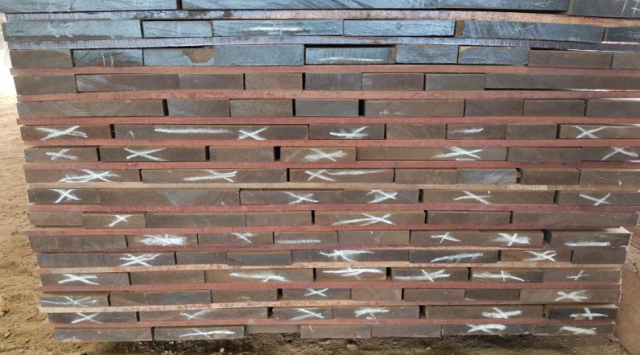please click here:
https://www.shdtimber.com/products.html
Wenge wood, derived from the African legume Millettia laurentii, is renowned for its striking appearance and exceptional durability. Native to Central and West Africa, this exotic hardwood has captivated artisans, designers, and luxury furniture manufacturers worldwide. Its deep, rich tones and unique grain patterns make it a sought-after material for a variety of applications, from high-end furniture to musical instruments, architectural accents, and decorative veneers.
Unlike common domestic woods, wenge carries a sense of exotic luxury. Its appearance ranges from dark brown to nearly black, often with fine black streaks running along the grain. The high density and hardness of wenge contribute to its reputation as a long-lasting and stable material, but also make it challenging to work with, requiring skill and precision.
Characteristics of Wenge Wood
Appearance
Wenge wood is immediately recognizable due to its deep, dark brown color interspersed with black streaks, giving it an almost tropical ebony-like appearance. Unlike uniform domestic hardwoods, wenge exhibits dramatic contrast within a single board, making each piece unique. The coarse texture and straight to interlocked grain patterns enhance its visual complexity. When polished with oil or varnish, wenge develops a rich sheen that accentuates its dark, dramatic hues.
Interior designers often use wenge as a focal point in contemporary or modern spaces. Its dark tones contrast beautifully with light-colored walls, metal accents, or glass surfaces, creating a sophisticated ambiance. Wenge veneers are also popular in cabinetry, where thin sheets of wood preserve the exotic aesthetic while reducing costs.
Density and Hardness
Wenge is one of the densest hardwoods available, with a Janka hardness rating ranging from 1,630 to 1,930 lbf. This makes it significantly harder than domestic hardwoods like red oak (1,290 lbf) or hard maple (1,450 lbf). Its density translates to high durability, resistance to abrasion, and long service life, which is why it is often chosen for high-traffic areas, flooring, and furniture that must withstand daily wear.
The heavy weight of wenge can pose logistical challenges during transport and installation. Designers and manufacturers must account for this when planning projects, especially for large furniture pieces or paneling installations.
Workability
Despite its beauty and strength, wenge is known to be difficult to work with. The density can quickly dull cutting tools, and its coarse grain can lead to splintering if not handled carefully. Edge routing, drilling, and sanding require sharp tools and patience. Additionally, wenge produces a fine dust that can irritate the skin and respiratory system, making personal protective equipment essential during processing.
Experienced craftsmen value wenge for its stability, resistance to warping, and the beautiful finishes it can achieve. With the right techniques, the wood can be turned, inlaid, or veneered to produce striking furniture and decorative objects.
Applications of Wenge Wood
Furniture
Wenge is highly favored in the world of luxury furniture. Its rich, dark color and natural luster create an air of sophistication in living rooms, offices, and dining areas. High-end tables, chairs, desks, cabinetry, and shelving units frequently feature wenge as a primary material. Designers often combine wenge with lighter woods such as maple or ash to create dramatic visual contrast in modern furniture designs.
Custom furniture makers appreciate wenge's dimensional stability, allowing precise joinery and tight-fitting panels. Its resistance to dents and scratches ensures longevity, making it ideal for heirloom-quality pieces that can last generations.
Flooring
Wenge flooring is an increasingly popular choice for luxury interiors. Its hardness and durability make it suitable for both residential and commercial spaces. Solid wenge flooring provides a deep, rich tone that adds warmth and elegance, while engineered wenge flooring offers a cost-effective alternative that is easier to install and less susceptible to environmental fluctuations.
In design, wenge flooring is often paired with neutral tones or minimalist furnishings to enhance the dramatic effect of the dark wood. The high contrast between wenge and lighter rugs, walls, or furniture highlights its aesthetic appeal.
Musical Instruments
Wenge's density and tonal properties make it an excellent choice for musical instruments. It is commonly used in guitar necks, fingerboards, drum shells, and other acoustic components where resonance and sustain are important. Compared to softer woods, wenge provides a bright, clear tone with strong projection, which is favored by professional musicians.
Notable manufacturers such as Ibanez, Warwick, and PRS incorporate wenge into their instruments, often in combination with maple, mahogany, or rosewood, to balance tonal characteristics and maintain structural stability. Its visual appeal also adds value to custom instruments.
Decorative Elements
Beyond functional uses, wenge is celebrated for its decorative potential. It is commonly used in veneers, wall paneling, inlays, and segmented woodturning projects. Wenge's dark streaks provide visual interest, particularly when paired with lighter woods or contrasting resin accents. Designers frequently use wenge to frame artwork, create luxury countertops, or accent architectural features.
In turnery, wenge is prized for its ability to hold sharp detail and create high-contrast patterns. The wood's dense grain allows precise carving, making it suitable for bespoke decorative items, luxury gifts, and artistic sculptures.
Sustainability and Environmental Considerations
Endangered Status
Millettia laurentii, the tree species from which wenge is harvested, is listed as endangered due to overharvesting and habitat loss in Central and West Africa. Unsustainable logging practices, illegal trade, and deforestation have contributed to its decline, raising significant ecological concerns.
Because of this status, buyers and designers are encouraged to prioritize certified sustainable sources or explore alternative materials. Responsible sourcing is essential not only for environmental conservation but also to ensure the long-term availability of this precious wood.
Sustainable Practices
Several suppliers now offer wenge from certified sustainable forests. Engineered products, such as thin veneers over a more abundant core wood, can also reduce the demand for solid wenge lumber while maintaining its aesthetic appeal. Some manufacturers implement chain-of-custody certifications to verify the legality and sustainability of harvested wood.
Education and awareness in the design community have further encouraged sustainable usage. Designers are increasingly mindful of material footprints, promoting wenge for high-impact pieces where its longevity can justify its environmental cost.
Alternatives
For environmentally conscious projects, alternative hardwoods can mimic wenge's appearance and properties. Panga panga (Millettia stuhlmannii), bubinga (Guibourtia spp.), and some tropical mahoganies provide similar color tones and grain patterns while being more abundant or sustainably sourced.
Additionally, modern composites and engineered wood products can simulate wenge's appearance without the ecological impact, offering designers more flexibility in achieving the desired aesthetic.
Wenge Wood vs. Other Exotic Hardwoods
| Feature | Wenge | Ebony | Panga Panga | Bubinga |
|---|---|---|---|---|
| Color | Dark brown to black | Black | Dark brown with streaks | Reddish-brown with darker streaks |
| Density | High | Very high | High | High |
| Hardness (Janka) | 1,630–1,930 lbf | 2,000–2,500 lbf | 1,800–2,000 lbf | 1,800–2,100 lbf |
| Workability | Challenging | Difficult | Moderate | Moderate |
| Sustainability | Endangered | Endangered | Less endangered | Less endangered |
While wenge and ebony share similar dark tones, wenge is generally more affordable and easier to source. Panga panga and bubinga are suitable alternatives for projects seeking a similar aesthetic with potentially lower environmental impact. Understanding the differences in hardness, density, and workability can guide material choice depending on the application.
Market Trends and Design Inspiration
The demand for wenge wood has fluctuated with the rise of sustainable design awareness. While luxury markets still prize its dark tones and durability, designers increasingly combine it with lighter materials, metals, or glass for contemporary aesthetics.
Wenge is frequently featured in high-end furniture shows, architectural projects, and bespoke instruments, often highlighting its contrast with natural light. Designers also experiment with wenge in creative pairings, such as resin inlays, marquetry, and hybrid wood products, pushing the boundaries of traditional woodworking.
Its exotic appeal continues to make it a favorite among luxury brands seeking both functional and decorative impact. Architects use wenge paneling to create striking reception areas, while interior designers specify wenge flooring or furniture for boutique hotels and luxury residences.
Maintenance and Care
Cleaning
Maintaining wenge's appearance requires gentle cleaning with a soft cloth and mild soap. Avoid abrasive cleaners or chemical agents that may damage the finish. Regular dusting also helps preserve the wood's natural luster.
Finishing
Oiling wenge periodically enhances its color and protects against moisture and wear. Finishes such as natural oils, waxes, or polyurethane can provide long-term protection. In high-traffic areas, reapplication may be necessary to maintain aesthetics.
Repair
Due to its density, wenge is harder to repair than softer domestic woods. Minor scratches or dents can often be minimized with sanding and refinishing. Deep gouges may require professional restoration to maintain structural integrity and visual appeal.
Conclusion
Wenge wood stands out as a luxurious, durable, and visually striking material. Its exotic appearance, combined with exceptional hardness and stability, makes it ideal for furniture, flooring, musical instruments, and decorative elements. Despite environmental concerns over its endangered status, responsible sourcing and alternative materials allow designers and craftsmen to continue using this precious wood sustainably.
Whether incorporated into high-end interiors, bespoke instruments, or artisan furniture, wenge adds depth, sophistication, and resilience to any project. Its enduring popularity reflects a combination of practical performance and timeless aesthetic appeal.
Article Summary
Wenge wood, sourced from the endangered Millettia laurentii tree, is prized for its dark tones, hardness, and stability. Commonly used in luxury furniture, flooring, and musical instruments, wenge requires skilled handling. Sustainable sourcing and alternative woods help reduce environmental impact while preserving its luxurious appeal.
Frequently Asked Questions
-
What is wenge wood?
Wenge wood is a dense, dark hardwood from the Millettia laurentii tree, native to Central and West Africa. -
Is wenge wood sustainable?
The species is endangered due to overharvesting, but certified sustainable sources and alternatives can reduce ecological impact. -
How should wenge wood be maintained?
Clean with a soft cloth and mild soap, and apply oil or finish periodically to protect its surface. -
Can wenge wood be used outdoors?
Yes, with proper treatment for moisture and insect protection, wenge can be suitable for outdoor applications. -
What are some alternatives to wenge wood?
Panga panga, bubinga, and certain engineered wood products mimic wenge's appearance while offering more sustainable sourcing options.






